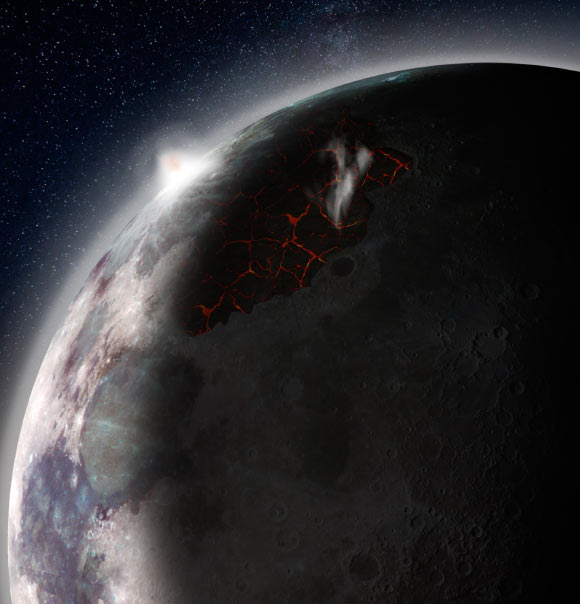About 3.5 billion years ago volcanic activity on Earth’s only permanent natural satellite produced an atmosphere 1.5 times thicker than is currently on Mars, according to new research published in the journal Earth and Planetary Science Letters.

Volcanic activity 3.5 billion years ago released 1019 g of volatiles around the Moon. Image credit: NASA.
“It just completely changes the way we think of the Moon. It becomes a much more dynamic planetary body to explore,” said Dr. Debra Needham, a planetary volcanologist at NASA’s Marshall Space Flight Center.
Discovering the existence, thickness and composition of the lunar atmosphere began with understanding how much lava erupted on the Moon 3.9 to 1 billion years ago, forming the lava plains we see as the dark areas on the surface of the Moon today.
Dr. Needham and her colleague, Lunar and Planetary Institute researcher Dr. David Kring, then used lab analyses of lunar basalts returned to Earth by the Apollo crews to estimate the amounts and composition of gases (volatiles) released during those volcanic eruptions.
The short-lived lunar atmosphere — estimated to have lasted approximately 70 million years — was comprised primarily of carbon monoxide, sulfur and water.
As volcanic activity declined, the release of the gases also declined. What atmosphere existed was either lost to space or became part of the surface of the Moon.
If only 0.1% of the water vented during those volcanic eruptions remains in the polar regions of the Moon, volcanically-derived volatiles could account for all hydrogen deposits — suspected to be water — currently observed in the Moon’s permanently shadowed regions.
“Water is one of the keys to living off of the land in space, also called in-situ resource utilization,” the researchers said.
“Knowing where the water came from helps scientists and mission planners alike know if the resource is renewable.”
“Ultimately, more research is needed to determine the exact sources.”
_____
Debra H. Needham & David A. Kring. 2017. Lunar volcanism produced a transient atmosphere around the ancient Moon. Earth and Planetary Science Letters 478: 175-178; doi: 10.1016/j.epsl.2017.09.002







